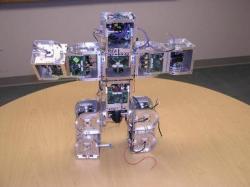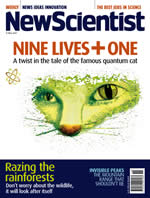Modular robot's wriggles show greater flexibility

- 18:20 22 February 2007
- NewScientist.com news service
- Tom Simonite

Related Articles
- No head required for 20-brained bot
- 30 July 2006
- Shape-shifting tetrabots tumble into action
- 09 April 2005
- Shape-shifting robot shows off its moves
- 17 November 2004
Web Links
A modular robot that transforms itself into different shapes in order to walk, crawl and clamber up inclines has been demonstrated in the US.
Its makers claim the flexible bot should be able to negotiate a wide variety of terrain and hope one day to send it on missions into space.
Each "Superbot" module is effectively a robot in its own right. The modules can move independently, flip over and rotate like wheels, and have 3D accelerometers that let them know their precise orientation.
The six sides of each module can dock with any other module. Once connected, the modules can communicate, coordinate shape changes and even transmit power.
Different styles
"Superbot consists of Lego-like, but autonomous, robotic modules that can reconfigure into different systems for different tasks," says Wei-Min Shen at the University of Southern California, US. For example, he says centipede-like movement could be used for burrowing while rolling like wheel would be a more efficient way to travel over long distances.
Videos show Superbot travelling in a variety of different arrangements. It can climb ropes (10MB, wmv format), roll like a wheel (2.4MB), inch along like a caterpillar (19MB), climb slopes (1.62MB), and even walk like a humanoid (7.9MB).
The robotic modules coordinate activity using their own sensors and those on other modules. To roll, for instance, each module must monitor the accelerometers inside other modules. They must all coordinate their movement so that its combined circular shape flexes itself correctly and moves forward.
Thruster modules
The team say Superbot could eventually make the perfect companion for astronauts based on the Moon or elsewhere in space. A few extra modules fitted with cameras or rock samplers would let a Superbot perform a variety of useful tasks.
One Superbot has already been used to carry a camera around on Earth and shoot its own video. Small thrusters could furthermore create "devices that can fly in a micro-gravity environment," Shen says.
Previous modular bots have experienced co-ordination problems, and sometimes require special modules to attain particular shapes. By giving each module greater physical flexibility, Shen says Superbot should be able to assume a wider array of shapes and travel along more efficiently.
Superbot was presented at the Space Technology and Applications International Forum 2007, held in Albuquerque, US, last week.

- For exclusive news and expert analysis every week subscribe to New Scientist Print Edition
- For what's in New Scientist magazine this week see contents
- Search all stories
- Contact us about this story
- Sign up for our free newsletter

- >Paired
satellites drift dangerously apart

20:18 15 May 2007 - >City
parks could cool urban areas by 4�C
18:34 15 May 2007 - >Virtual
art dealers use trust to trade effectively
18:21 15 May 2007
- >Paired
satellites drift dangerously apart

20:18 15 May 2007 - >Ring
of dark matter surrounds cosmic collision

18:08 15 May 2007 - >Mars
experiment might help insomniacs on Earth
14:58 15 May 2007















